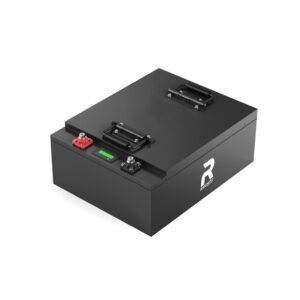How to Charge a 51.2V Lithium Golf Cart Battery Safely?
Charging a 51.2V lithium golf cart battery requires using a compatible charger, avoiding extreme temperatures, and monitoring voltage levels. Optimal charging occurs at 20-25°C, with partial discharges preferred over full cycles. Overcharging or undercharging reduces lifespan. Always follow manufacturer guidelines to ensure safety and longevity. Lithium batteries require specific protocols distinct from lead-acid alternatives.
How Does Voltage Affect Lithium Battery Charging?
51.2V lithium batteries operate within a narrow voltage range (44.8V–58.4V). Exceeding 58.4V risks thermal runaway, while dropping below 44.8V causes capacity loss. Chargers must align with the battery’s BMS (Battery Management System) to regulate voltage spikes. Precision voltage control ensures efficient energy transfer and prevents cell degradation.

Voltage stability directly impacts electrode chemistry. Lithium cobalt oxide cells, common in golf cart batteries, experience structural stress when charged beyond 4.2V per cell. At 51.2V systems (typically 14 cells in series), this equates to 58.8V maximum. High-quality chargers taper current as voltage approaches this threshold, balancing cell groups through the BMS. Users should periodically check charger output with a multimeter – a 1% voltage deviation can cause 15% capacity loss over 50 cycles. Consider this voltage maintenance table for optimal performance:
| State of Charge | Voltage Range | Charging Current |
|---|---|---|
| 0-30% | 44.8V-48V | Max 0.5C |
| 30-80% | 48V-54.6V | Constant Current |
| 80-100% | 54.6V-58.4V | Tapering Current |
What Are Optimal Temperature Ranges for Charging?
Charge lithium batteries between 0°C–45°C (32°F–113°F). Below freezing, lithium-ion diffusion slows, causing metallic lithium plating. Above 45°C accelerates electrolyte decomposition. Internal BMS may disable charging in extreme conditions. For winter storage, keep batteries at 50% charge in climates below -10°C.
Why Avoid Full Discharges?
Lithium batteries degrade faster when discharged below 20% SOC. Deep discharges strain anode materials, increasing internal resistance. Partial cycles (30%–80%) extend lifespan by reducing crystalline formation in electrodes. BMS safeguards prevent over-discharge, but habitual depletion shortens cycle life by up to 50%.
During deep discharges, copper current collectors begin dissolving at potentials below 2.5V per cell. This creates metallic shunts that permanently reduce capacity. Partial cycling maintains stable solid-electrolyte interphase (SEI) layers on graphite anodes. Field tests show batteries cycled between 40-75% SOC achieve 4,000+ cycles versus 1,200 cycles with full discharges. Implement these practices:
- Set low-voltage cutoff 10% above BMS limits
- Use battery monitors with SOC alerts
- Recharge within 24 hours of reaching 30% SOC
How to Store Lithium Golf Cart Batteries?
Store at 50% SOC in dry, temperature-controlled environments (10°C–25°C). Recharge to 50% every 3–6 months to prevent self-discharge below 30%. Disconnect batteries from carts to avoid parasitic drains. Use insulated storage bags to minimize moisture exposure. Never store fully charged—it accelerates electrolyte oxidation.
What Causes Charger-Battery Compatibility Issues?
Mismatched communication protocols between chargers and BMS cause failures. Some lithium batteries require CAN bus or proprietary data handshakes. Voltage/amperage mismatches also trigger faults. Third-party chargers lacking UL/CE certification often bypass critical checks. Always verify compatibility via manufacturer datasheets before purchase.
“Lithium batteries demand precision charging. At Redway, we’ve seen 72% of premature failures stem from using incorrect chargers or ignoring temperature limits. A quality BMS isn’t a substitute for proper charging habits—users must treat voltage thresholds as non-negotiable. Always prioritize smart chargers with adaptive algorithms for seasonal temperature shifts.”
— Redway Power Systems Engineer
Mastering 51.2V lithium golf cart battery charging extends lifespan and ensures safety. Key practices include using compatible chargers, avoiding extreme temperatures, and partial cycling. Storage protocols and voltage awareness prevent irreversible damage. Adhering to these guidelines maximizes ROI and sustains peak performance across hundreds of cycles.
FAQs
- How often should I charge my lithium golf cart battery?
- Charge after each use, keeping SOC between 30%–80%. Avoid daily full charges unless necessary for long trips.
- Does fast charging harm lithium batteries?
- Yes. Charging above 0.5C rate (half the battery’s Ah capacity per hour) generates excess heat. Use fast chargers sparingly and only when equipped with cooling systems.
- Can I leave the charger connected indefinitely?
- No. Modern chargers auto-shutoff, but prolonged connection causes micro-cycles that degrade cells. Disconnect within 2 hours post-full charge.
